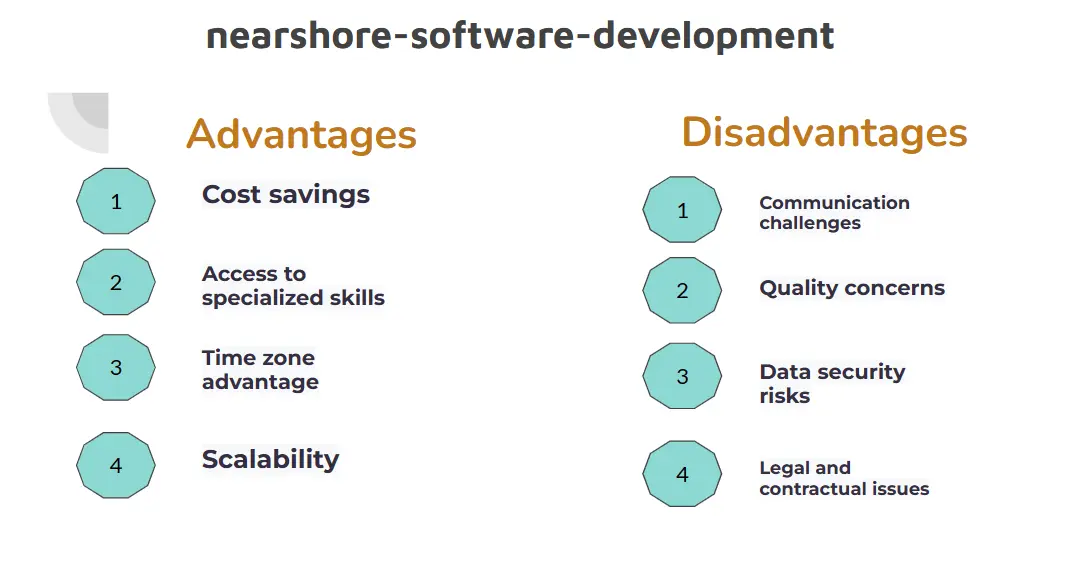What is the difference between nearshore and offshore software development?

When it comes to software development, companies have the option to choose between nearshore and offshore development services. Both nearshore and offshore development offer several advantages, but there are key differences between the two approaches that companies should consider before making a decision.
Nearshore software development involves contracting a team of developers who are located in a neighboring country or region. This means that the developers are in a similar time zone and share similar cultural norms, making communication and collaboration much easier. Nearshore development teams also tend to have a better understanding of the local market and business practices, which can be beneficial for companies looking to expand their operations to new regions.
Nearshore software vs Offshore software - What's the Difference?
When it comes to outsourcing, businesses have two main options: nearshore and offshore. Both offer various benefits, but they cater to different needs and preferences. In this article, we will break down the key differences between nearshore and offshore outsourcing.
Nearshore Outsourcing:
Nearshore outsourcing involves transferring business processes or tasks to a neighboring country. This means that the outsourcing company and the service provider are in close geographical proximity, often in the same time zone or just a few hours apart. For example, companies in the United States might choose to nearshore to countries in Latin America, such as Mexico or Brazil.
The benefits of nearshore outsourcing include:
- Proximity and Time Zone: Being in close geographical proximity allows for better communication and collaboration between the outsourcing company and the service provider. This can result in faster response times and the ability to work in real-time.
- Cultural Similarities: Nearshore outsourcing often involves countries that share similar cultures and languages. This can lead to better understanding and alignment on business practices and objectives.
- Cost Savings: While nearshore outsourcing may not always be as cost-effective as offshore outsourcing, it can still result in significant cost savings compared to keeping processes in-house
Offshore Outsourcing:
Offshore outsourcing, on the other hand, involves transferring business processes or tasks to a country that is significantly farther away, often in a different time zone. Companies in the United States might choose to offshore to countries in Asia, such as India or the Philippines.
The benefits of offshore outsourcing include:
- Cost Savings: Offshore outsourcing is typically more cost-effective than nearshore outsourcing, as countries in Asia often have lower labor costs.
- Scalability: Offshore outsourcing offers access to a larger talent pool, allowing businesses to scale their operations more easily and take on larger projects.
- 24/7 Operations: With the time zone differences, offshore outsourcing can enable businesses to operate around the clock, leading to increased productivity and faster turnaround times.
Advantages and Disadvantages of Nearshore Software Development

Nearshore software development is a popular outsourcing option for businesses looking to develop software applications with a team located in a nearby country.
Advantages of Nearshore Software Development:
- Proximity: One of the biggest advantages of nearshore software development is the physical proximity to the outsourcing team. This can lead to better communication, collaboration, and easier travel for meetings and project updates.
- Time Zone Compatibility: Nearshore teams are usually located in a similar time zone, which can result in easier collaboration and faster response times to issues or changes in the project.
- Cultural Compatibility: Nearshore teams often have a similar culture and work ethic, making it easier to work together and understand each other's communication styles.
- Cost-effective: While nearshore development may not be as inexpensive as offshore outsourcing, it can still be more cost-effective than hiring in-house developers.
- Quality of Work: Nearshore teams often provide high-quality work due to their proximity, time zone compatibility, and cultural similarities.
Disadvantages of Nearshore Software Development:
- Language Barriers: While nearshore teams may share a similar culture and work ethic, there may still be language barriers that can impact communication and understanding.
- Higher Costs: Nearshore software development may still be more costly than offshore outsourcing, especially if the outsourcing team is located in a more developed country with higher labor costs.
- Limited Talent Pool: Depending on the location of the nearshore team, there may be a limited talent pool to choose from, which can impact the quality and expertise of the developers working on your project.
- Data Security Concerns: Outsourcing software development to a nearshore team may raise concerns about data security and intellectual property protection, especially if the outsourcing team is located in a country with weaker regulations.
- Dependency on External Team: Working with a nearshore team means relying on external resources for your software development needs, which can result in delays or issues if the outsourcing team is not able to meet deadlines or deliver as expected.
